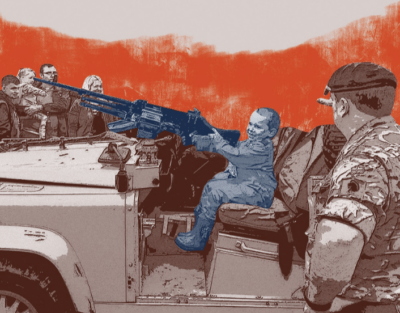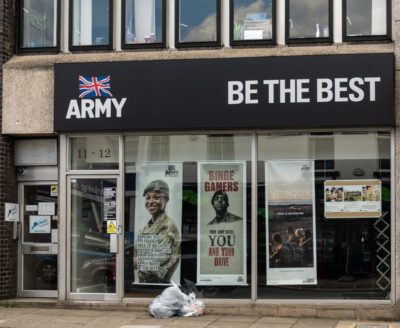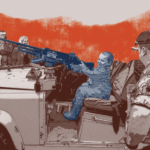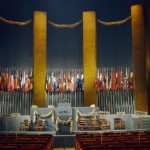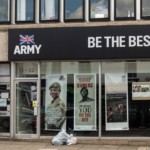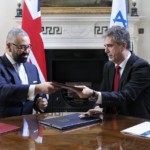A former cadet’s experience of the Combined Cadet Forces
ForcesWatch comment
Looking back on being part of a school-based cadet unit, the author reflects that, despite the fun and experience to be gained, the benefits could be achieved with non-military activities which would not present a dangerous and risk-laden career as an enjoyable and exciting activity or expose young people to an environment where bullying and hazing are normalised.
What follows is an autobiographical account of my experiences as an Army Cadet within the Combined Cadet Forces (CCF). As such, it serves as a snapshot of the organisation at a particular time and place, and should not be regarded as a definitive record as to how the CCF operates as a whole. Whilst each detachment of the CCF adheres to the same syllabus and ethos, the method by which this is implemented may vary with the leadership, members and social culture of that detachment. I have provided this disclaimer purely because aspects of my testimony may seem controversial, and it would be unfair to discredit an entire organisation on the basis of my personal memories alone.
The CCF is a Ministry of Defence (MoD) sponsored youth organisation predominantly found within the United Kingdom’s independent schools.i Divided into three branches (Army, Royal Air Force and Royal Navy). Members can join from the age of thirteen until they leave school at eighteen. They wear military fatigues, and are provided with military training once a week, on occasional night-time exercises, and on biannual week-long camps located at military barracks.ii It is designed to be fun, and indeed is fun, as evidenced by this author staying a cadet for the maximum five years before he left school turned eighteen. The CCF was an integral component of every-day school life. Every Thursday our uniform of blazer and tie was replaced with brassard and khaki, and school would finish quarter of an hour early to enable us to file onto the parade square. Even the school’s infrastructure was set up to facilitate our military education. An armoury, replete with ammunition and weapons, was conveniently located in the English Department, with a nearby mess for the teachers who volunteered as officers.iii This ensured that a military ethos was ever present throughout our education, even when we were not practising as Cadets.
All the Services are particularly keen not to overtly link cadets and recruiting and this must continue in the public eye.’ MoD Youth Engagement Review 2011
Recruitment and the CCF
Whilst the CCF promotes self-reliance, leadership and other positive attributes within its members, it is primarily designed to ‘stimulate an interest’ in the armed forces and to encourage and prepare those with an interest in becoming officers within the regular or reserve forces to enlist.iv As stated in an interim copy of the MoD’s Youth Engagement Review, ‘Cadet and [MoD] youth development experiences…can both enhance a young person’s desire to join the Service and make him/her better prepared to enter training…All the Services are particularly keen not to overtly link cadets and recruiting and this must continue in the public eye.’v In short, the CCF is designed to enable young men and women to regard the armed forces as a viable career, and one that they have already been primed for success.
This pre-emptive channelling occurred in a variety of ways. Talks were often delivered by current or former officers, who reiterated certain myths about an armed forces career, and largely glossed over the fact that ultimately soldiers exist to be called upon by their government to kill other humans for political reasons. The armed forces were presented to us as a great adventure, where we would undertake exciting new experiences in exotic locations far away, making friends for life along the way. Certainly, there is some truth to this depiction, however, it may also mislead impressionable young people into thinking that the armed forces is safer and more enthralling than it actually is. This illusion would likely be shattered if these hypothetical new recruits were mobilised for war.
An even more effective recruitment tactic, however, were the trips to the various regiments, where we were seduced by the pomp, silver and ceremony of mess life as an officer, and the deadly power and technology of the weapons, equipment and hardware used by the British armed forces. A personal highlight was being driven in a challenger tank by the Royal Artillery. Looking back, the CCF, and the resources invested in our training were, as the MoD state themselves, a ‘powerful tool for facilitating recruitment’.vi Indeed, 20% of officers and 2% of non-officers in 2014 are former members of the CCF and 27% of officers and 23% of non-officers are former members of community-based cadet units.vii This reflects the traditional predominance of school-based cadets in independent schools which are more likely to produce officers rather than ‘other ranks’.
Realism and Training
Realism was key to optimising our experience as cadets in the CCF. Of course, no platoon attack or sentry duty could ever accurately imitate the fear and risk that saturates the experiences of regular soldiers on patrol or in combat, however, every effort was made to make our exercises mimic real world British operations overseas. I remember firing blanks at more senior cadets, who would don shemaghs as turbans and keffiyehs, presumably to replicate the United Kingdom’s wars in Afghanistan and Iraq. I remember in one FIBUA (Fighting in Built Up Areas) exercise, we were greeted by a replica town, that as a small section we were required to navigate and secure. Originally intended to be a city in Northern Ireland, it had been remodelled into a middle-eastern settlement, complete with call-prayer being heard from the tannoy. As fourteen year olds, we were made acutely aware of who the United Kingdom’s current enemies were, and trained to defeat and kill them.
Learning how to operate and fire a rifle safely was an integral part of the CCF experience. It was regarded as a failure to have not passed the weapon handling test in time for our first Easter camp, and an emasculation if you had to use a stick during field-exercises instead of a rifle. Indeed, I chose to join the Army Stream of the CCF over the RAF and Navy streams, because of their preoccupation with ‘guns’ – or rifles to use the more accurate term – and because it was seen as the more masculine option, which as a rather weedy boy particularly appealed to me.
Although training often occurred with an L98 A1 Cadet GP rifleviii – which differed from the standard issue SA80 A1 rifle, in having a larger cocking handle, more rudimentary sight than the SUSAT sight, and the inability to fire automatically or semi-automatically – essentially it was the same weapon, and occasionally we would use the SA80 in both training and exercises. I also received training on the Light Support Weapon (LSW). On exercise, we would always fire blank ammunition, however, we would fire live ammunition on range days. Using these weapons eventually became an unconscious reflex, and to this day, I would feel entirely comfortable with picking up any of these weapons, carrying out the Normal Safety Procedure (NSP), and firing. Should I wish to join the army, I would have a considerable advantage over those who were not previously in the CCF.
As a recent promotional leaflet from the CCF’s sister organisation, the Army Cadet Force (ACF) states, ‘You won’t be part of the Army but if that’s what you’re interested in, you’ll get a taste of Army life and a head start over the competition’.ix Always great fun were the Dismounted Close Combat Trainer (DCCT) ranges.x They took place indoors, with us facing a giant computer screen. The SA80 Rifles were digitally modified to register where the rifle was aimed when we pulled the trigger. This allowed us to enjoy firing upon digitally-rendered platoons advancing towards us. Killing was made fun for us millennials, and was distanced from the stressful and terrifying environment of real-life military operations, thanks to advances in video-game technology.
Interactions with regular servicemen
Personally, one of the more fascinating aspects of the CCF was the various interactions with soldiers or veterans, who would give us more authentic accounts of life and war as service personnel, than the recruiters who would visit our school. Some of these war recollections were particularly gruesome, including a rather visceral description of what a burnt Iraqi ran over by a tank looks like. (The pink and black make for an interesting contrast apparently). Truth be told, I cannot remember the exact tone these war stories were relayed to us, whether they were told with macho bravado, to impress us, or whether they were designed to be cautionary tales; a deliberate attempt to dissuade us from pursuing an armed forces career. Occasionally, it was the soldiers and veterans themselves who found it difficult to interact with us, one such incident took place during a question and answer session when a younger cadet asked an officer whether he had ‘looked someone in the eye and killed them?’ I remember the officer being fairly upset by the question, and declined to answer.
Bullying and ‘hazing’ were fairly institutionalised within the CCF, particularly during camps. Whether this was a product of the militarised space and culture we found ourselves in, or the result of isolating young adolescents within a billet, is uncertain.
Bullying and Camaraderie
Bullying and ‘hazing’ were fairly institutionalised within the CCF, particularly during camps. Whether this was a product of the militarised space and culture we found ourselves in, or the result of isolating young adolescents within a billet, is uncertain.xi xii
This aspect of CCF life was largely accepted and tolerated for a number of reasons. Firstly, the bullying and hazing was hierarchical. The Non-Commissioned Officers (NCOs) of between sixteen and eighteen, were the ones who would often bully or perform the hazing rituals against younger cadets, and these younger cadets knew that when they became experienced enough to become NCOs, that they would be granted the right to bully and distribute punishment. Secondly, bullying and hazing was collectivised, younger cadets were rarely singled out, except for a severe case of subordination against an older cadet, and similarly no one was granted immunity, and this functioned to build a sense of camaraderie amongst the younger cadets.
However, bullying and hazing was never an exact science, some cadets were inevitably upset by this aspect of the CCF, and occasionally, due to the violent nature of hazing, cadets would get injured. Such hazing rituals included ‘lamp-posting’ where cadets were restrained to their beds using bungee cords, and their bed was placed upright against a wall, or ‘gauntlets’, where one had to make it across an alley of other cadets, who were allowed to throw punches. On rarer occasions it was the officers or veterans embedded within our unit who would resort to verbal taunting, or dish out minor punishment, such as press-ups. This was primarily to motivate us to perform better in whatever task, drill, or duty we were performing at the time, but occasionally upset certain cadets.
However, as many cadets will testify, the most rewarding aspect of being in the CCF, was the spirit of camaraderie and fraternity enjoyed with your fellow cadets, and the friendships created out of the shared experiences and tribulations. In order to become an NCO one must pass the Cadre, a series of challenging assessments testing our skills as instructors, and a gruelling exercise that saw us spend three nights in the field, with very little sleep, and the stress of continually reacting to enemy fire. The elation we shared together having completed this exercise, and the pride of being allowed to ‘pass-out’ in front of the whole contingent, is something that I have rarely experienced since. Personally, this camaraderie made up for the hazing and bullying levied against us by senior cadets, however, others would probably disagree.
Conclusion
The CCF was certainly a fun experience, that honed my skills in leadership, resilience and self-reliance, all ‘buzz-words’ associated with the Department for Education’s ‘Military Ethos in Schools Programme’.xiii However, the author feels that these outcomes can easily be achieved, without training children to kill, and without presenting a dangerous and risk-laden career as an enjoyable and exciting activity to impressionable young minds. Similarly, this author believes that these outcomes can be achieved (perhaps even better) without placing children in an environment where bullying and hazing are normalised. Many non-militaristic initiatives exist which socially-develop children in a positive way, an example being the Woodcraft Folk.xiv However, these are rarely afforded nearly the same resources as their militarised counterparts.xv
Furthermore, concerns have recently been raised regarding cadet safety. A recent MoD directive for example, banned cadets wearing uniform to and from school, over concerns that their military identity may render them potential targets for extremists.xvi A CCF detachment has also previously been disbanded because of safety concerns regarding the storage of weapons within the school’s premises.xvii
In many ways, my comrades and I were lucky. Coming from a middle-class background we were given a variety of opportunities other than the armed forces to pursue as future careers. Even if we had chosen to enlist, we would have joined as officers where the risks are greatly reduced in comparison to those serving as non-officers. My main concern is that the current government, and the Coalition Government that preceded it, are using militarised youth schemes, such as the CCF, rather than their non-violent counterparts, as a solution to social-disadvantage within the United Kingdom. As evidenced in the Coalition Government’s commitment to introducing one-hundred new CCF units in state schools by September 2015. This may work to a certain extent, but only by channelling vulnerable young men and women from deprived backgrounds into the most dangerous roles the armed forces have to offer. This may help resolve the United Kingdom’s current recruitment crisis, but it is a temporary solution to social disadvantage, as the risks and downsides involved in these dangerous roles, mean that some may leave with physical or mental injuries which will leave them more disadvantaged than before they enlisted.
Currently in British society, there is an all too uncritical attitude towards the CCF and the militarisation of childhood, and this needs to change.
Notes
i At the end of the Academic Year 2010-11 there were 257 CCF contingents across the UK. 196 were based in independent schools. A recent Coalition Government initiative has expanded the CCF into disadvantaged English state schools, creating 100 new units. The government has now committed £50 million to increasing the numbr of state school CCFs to 500 by 2020 (an increase of roughly 310 units). There are also roughly 170 ‘community’ Army, Sea and Air Cadet units based in schools, something that the MoD is encouraging; some of them are purely for students at the school, and do activities in school time, so they are not that different to the CCF. See: United Kingdom., 2012a. More Cadets for our Communities. [press release] 30 June 2012. Available at: https://www.gov.uk/government/news/more-cadets-for-our-communities–2 [Accessed 31 March 2015]; http://www.theyworkforyou.com/wrans/?id=2015-06-02.900130.h&s=cadet#g900130.r0 [Accessed 31 March 2015]; http://schoolsweek.co.uk/cadet-units-in-state-schools-to-increase-five-fold-with-50-million-budget-boost/ [accessed 9 July 2015]; and draft of MoD Youth Engagement Review 2011, obtained by ForcesWatch by Freedom of Information request in July 2012.
ii See https://www.youtube.com/watch?v=iaoFJF3c9Xk and https://www.youtube.com/watch?v=23tbJvYjYAo for an insight into the CCF experience. It should be noted that the up-beat music, slow-motion and stylistic/cinematic presentation of the CCF and their activities, particularly in the latter video, may serve to glorify and sanitise militarism. It is a similar technique used by the British Army in their recruitment videos. See for example https://www.youtube.com/watch?v=sOhvjBwuix4 and https://www.youtube.com/watch?v=GPY12BFxP_w&src_vid=sOhvjBwuix4&feature=iv&annotation_id=54c20788-0000-2f9b-8dc8-001a113f5c8c.
iii A mess is a common-room where military personnel socialise and dine together. It is usually reserved for officers.
iv See Plastow, J., 2011. Youth Engagement Review: Final Report. Available at https://www.gov.uk/government/uploads/system/uploads/attachment_data/file/28390/20120705_yer_final.pdf [Accessed 31 March 2015]. Particularly Section I-2.
v See Draft/Interim Youth Engagement Review distributed on the 24th June 2011, obtained by ForcesWatch on 2nd July 2012. It should be noted that these comments are not published in the finalised Youth Engagement Review, which is available at https://www.gov.uk/government/uploads/system/uploads/attachment_data/file/28390/20120705_yer_final.pdf
vi See Ministry of Defence, 2005. Strategy for Delivery of MOD Youth Initiatives.
vii See Table B2.4, Armed Forces Continuous Attitudes Survey Reference Tables 2014. Available at https://www.gov.uk/government/uploads/system/uploads/attachment_data/file/312672/afcas_2014_annex_b_reference_tables.pdf [Accessed 31 March 2015].
viii This rifle has since been replaced with a new cadet rifle, more similar to SA80 A1.
ix See https://armycadets.com/uploads/brand_centre/ACF_A5_rollfold_REV_web.pdf?cachebuster:8 Published January 2015.
x See Video https://www.youtube.com/watch?v=Eb5Y_1u_Qk0.
xi A Billet is an accommodation block that can house between six and thirty cadets.
xii See http://www.heraldscotland.com/news/crime-courts/private-school-cadets-charged-with-assault.25161738 for example of bullying and abuse carried out by cadets within the CCF.
xiii For more information on the Military Ethos in Schools Programme, see http://www.forceswatch.net/blog/alternative-provision-military-ethos-receives-more-funding-response
xiv See https://woodcraft.org.uk/ for more details.
xv See for example http://www.independent.co.uk/news/education/schools/where-gordonstoun-leads-will-other-british-schools-follow-9847801.html and the winners of the 2015 Department for Education character awards, none of which deployed a military ethos: https://www.tes.co.uk/teaching-resource/dfe-character-awards-11027687.
xvi See http://www.dailymail.co.uk/news/article-2332148/Cadets-told-wear-uniforms-ordered-cover-terrorist-attack-fears.html and also http://www.mirror.co.uk/news/uk-news/cctv-released-after-two-men-5120040.
xvii See http://www.archive.eastlothiancourier.com/news/roundup/articles/2009/12/24/395383-unique-cadet-force-fired-
See more: cadets, military in schools/colleges, recruitment, character building, military ethos
Like what you read?
> Sign up for our newsletter or blog notifications
> Support our work – from just £2 a month

